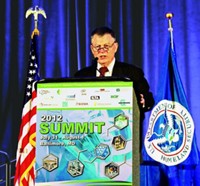Advertisement
Grab your lab coat. Let's get started
Welcome!
Welcome!
Create an account below to get 6 C&EN articles per month, receive newsletters and more - all free.
It seems this is your first time logging in online. Please enter the following information to continue.
As an ACS member you automatically get access to this site. All we need is few more details to create your reading experience.
Not you? Sign in with a different account.
Not you? Sign in with a different account.
ERROR 1
ERROR 1
ERROR 2
ERROR 2
ERROR 2
ERROR 2
ERROR 2
Password and Confirm password must match.
If you have an ACS member number, please enter it here so we can link this account to your membership. (optional)
ERROR 2
ACS values your privacy. By submitting your information, you are gaining access to C&EN and subscribing to our weekly newsletter. We use the information you provide to make your reading experience better, and we will never sell your data to third party members.
Policy
Chemical Plant Safety
by Rudy M. Baum
March 5, 2012
| A version of this story appeared in
Volume 90, Issue 10
The lead story in this week’s Government & Policy Department is a sober examination of the Department of Homeland Security’s dysfunctional Chemical Facility Anti-Terrorism Standards (CFATS). The story is by Senior Editor Glenn Hess, who has been covering CFATS since the program was created by Congress in 2006.
CFATS is of enormous importance to the chemical industry, but it has been plagued since its inception by uncertainty over its future, its purview, and the level of regulatory authority it should exercise. Deep concerns about CFATS emerged in late 2011 when the existence of an internal DHS report evaluating the program became known after Fox News posted a story on it (C&EN, Jan. 9, page 6).
That report still has not been released by DHS, but members of Congress have access to it, and it informed a subcommittee hearing of the House of Representatives Committee on Energy & Commerce held in early February, which Hess observed. A memorandum to the subcommittee members from committee staff states that the report “identifies five main programmatic challenges for the CFATS program: inadequate training capability, an overreliance on hired consultants for expertise, inappropriate transitions for new hires, uncertainty from extremely short program authorizations, and issues regarding job descriptions and the presence of an employee union.”
Hess reports that subcommittee members were withering in their criticism of the CFATS program. Rep. Joe L. Barton (R-Texas) pointed out that CFATS has received 4,200 site security plans but has yet to conduct a single compliance inspection. “This is beyond disappointing,” Barton told Rand Beers, head of DHS’s National Protection & Programs Directorate, at the hearing. “You have totally mismanaged this program by allowing it to continue to consume over $90 million a year without having a well-developed direction and plan.”
It’s clear that the federal government has a compelling interest in ensuring the integrity of chemical plants against terrorist attacks. Many chemical plants could be tempting targets for terrorists because, let’s be honest, some chemicals are very dangerous and, if released, could cause massive civilian casualties. However, for a number of reasons, the CFATS program is a fairly glaring example of good intentions leading to suboptimal results.
As Hess points out, “CFATS is based on a 744-word ‘rider’ that lawmakers attached to the DHS spending bill for fiscal 2007. It directed DHS to develop and adopt, within six months, a full-scale regulatory program to address the potential risks at thousands of chemical facilities nationwide.” In his testimony at the hearing, Beers essentially admitted that the haste involved in setting up CFATS resulted in people being hired before their job descriptions were written. Small wonder that this “resulted in the hiring of some employees whose skills did not match their ultimate job responsibilities,” as Beers testified.
Hess also alludes to another important tension that has plagued the CFATS program—the debate over whether DHS should have regulatory authority to require chemical facilities to adopt “inherently safer technology” (IST) to make them less appealing targets for terrorists. The chemical industry is vehemently opposed to this approach, and most congressional Republicans support the industry position. Environmentalists believe that IST is the best approach for reducing the risk from chemical facilities, and many Democrats agree.
To environmentalists, IST is a panacea, and they mount appealing but overly simplistic arguments for IST to be enshrined in regulations enforced by DHS. The chemical industry, Hess points out, “has fought hard to keep government mandates for alternative chemical processes out of the antiterrorism program, arguing that inherent safety is a well-established engineering process concept—not a security measure.” (ACS has a nuanced public policy statement on IST that is worth reading.)
This is a case where the chemical industry and its allies are right. IST is an important concept, but it should not be part of CFATS regulations enforced by DHS.
Thanks for reading.




Join the conversation
Contact the reporter
Submit a Letter to the Editor for publication
Engage with us on Twitter